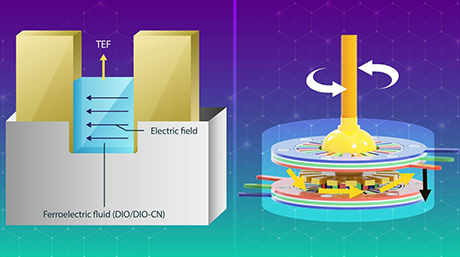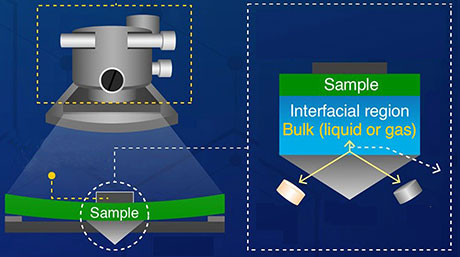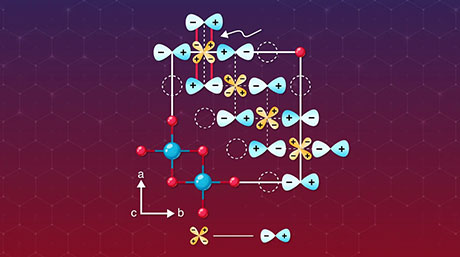Materials Science and Engineering News
Ultra-thin ferroelectric material for next-generation electronics
Scientists at Tokyo Tech have demonstrated the potential of a new, thin-film ferroelectric material that could improve the performance of next-generation sensors and semi-conductors.
'Ferroelectric' materials can switch between different states of electrical polarization in response to an external electric field. This flexibility means they show promise for many applications, for example in electronic devices and computer memory. Current ferroelectric materials are highly valued for their thermal and chemical stability and rapid electro-mechanical responses, but creating a material that is scalable down to the tiny sizes needed for technologies like silicon-based semiconductors (Si-based CMOS) has proven challenging.
Now, Hiroshi Funakubo and co-workers at the Tokyo Institute of Technology, in collaboration with researchers across Japan, have conducted experiments to determine the ferroelectric properties of an inorganic compound called hafnium oxide (HfO2) for the first time. Crucially, the crystal structure of HfO2 allows it to be deposited in ultra-thin films, meaning it may prove invaluable for next-generation technologies.
Ferroelectric properties stem from the shape and structure of the crystal used. The team knew that an 'orthorhombic' crystal of HfO2 would likely exhibit ferroelectricity. Funakubo's team wanted to pinpoint the material's spontaneous polarization and the Curie temperature (the point above which a material stops being ferroelectric due crystal re-structuring). To do this, they needed to grow a carefully-ordered crystal on a substrate, a process known as epitaxy, which would give them well-defined data on an atomic scale.
The researchers found that one particular epitaxial film, labelled YHO-7, exhibited ferroelectricity with a spontaneous polarization of 45 μC/cm and a Curie temperature of 450 ℃ (see image). The experimental results confirm earlier predictions using first principle calculations.
From a scientific and industrial point of view, a Curie temperature of 450 ℃ is of great interest, because it means the material could fulfil functions for future technologies. In contrast to many existing ferroelectric materials, the new thin-film exhibits compatibility with Si-based CMOS and is robust in miniature forms.
Background
Ferroelectric materials
Ferroelectric materials differ from other materials because their polarization can be reversed by an external electric field being applied in the opposite direction to the existing polarization. This property stems from the materials' specific crystal structure. Ferroelectric materials are highly valuable for next-generation electronics. While a number of ferroelectric materials are known to science and are already used in different applications, their crystal structure does not allow them to be scaled down to a small enough, ultra-thin film for use in miniaturized devices.
The material used by Funakubo and co-workers, hafnium oxide (HfO2), had previously been predicted to exhibit ferroelectric properties through first principle calculations. However, no research team had confirmed and examined these predictions through experiments. Funakubo's team decided to measure the properties of the material when it was deposited in thin-film crystal form onto a substrate. The precise nature of the crystal structure enabled the researchers to pinpoint the material's properties in full for the first time.
Their discovery of a particular epitaxial thin-film crystal of HfO2 that exhibits ferroelectricity below 450 ℃ will be of great significance in the field.
Implications of the current study
Funakubo's team are hopeful that their new thin film ferroelectric material will have applications in novel random-access memory and transistors, along with quantum computing. Their material is also the first ferroelectric material compatible with silicon-based semiconductors (Si-based CMOS).

Figure. Integrated intensity of YHO-7 110 diffraction peak as a function of temperature
Reference
| Authors: | Takao Shimizu1, Kiliha Katayama2, Takanori Kiguchi3, Akihiro Akama3, Toyohiko J. Konno3, Osami Sakata4, Hiroshi Funakubo1, 2, 5* |
|---|---|
| Title of original paper: | The demonstration of significant ferroelectricity in epitaxial Y-doped HfO2 film |
| Journal: | Scientific Reports |
| DOI: | 10.1038/srep32931 |
| Affiliations: | 1 Materials Research Center for Element Strategy, Tokyo Institute of Technology 2 Interdisciplinary Graduate School of Science and Engineering, Tokyo Institute of Technology 3 Institute for Materials Research, Tohoku University 4 Synchrotron X-ray Station at SPring-8, National Institute for Materials Science 5 School of Materials and Chemical Technology, Tokyo Institute of Technology |
- Thin films offer promise for ferroelectric devices | Tokyo Tech News
- Funakubo Laboratory
- Researcher Profile | Tokyo Tech STAR Search - Takao Shimizu
- Researcher Profile | Tokyo Tech STAR Search - Hiroshi Funakubo
- Materials research Center for Element Strategy (MCES)
- Latest Research News
School of Materials and Chemical Technology
—Encompassing the Disciplines of Science—
Information on School of Materials and Chemical Technology inaugurated in April 2016
Further information
Professor Hiroshi Funakubo
School of Materials and Chemical Technology
Email funakubo.h.aa@m.titech.ac.jp
Tel +81-45-924-5446






